There’s something quietly magical about pulling a golden, puffed-up German pancake from the oven, like watching a cloud rise in your kitchen, then slowly settle into a soft, buttery valley. If you’ve never made one, this might just become your go-to breakfast ritual. And if you have? Well, you already know why it’s worth making again.
German pancakes, sometimes called Dutch babies, are the oven’s answer to the lazy Sunday pancake flip. No mess, no griddle duty. Just six ingredients, one pan, and a whole lot of “Wow, you really made this?” energy.
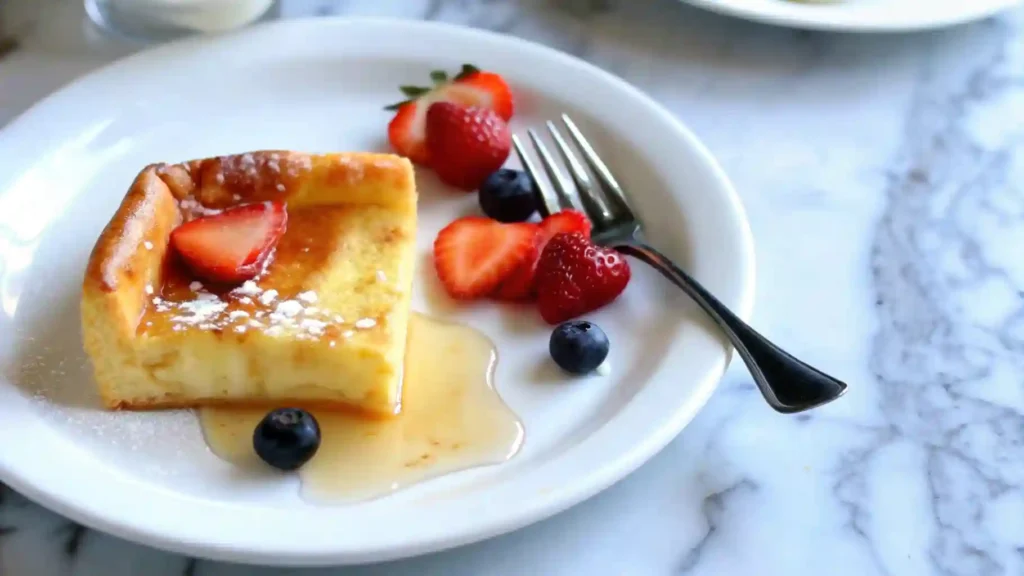
This recipe is for anyone who craves something special but doesn’t want to overthink breakfast. Whether you’re feeding toddlers, brunching with friends, or flying solo with a hot cup of coffee and a fork, this pancake delivers a moment of cozy, café-style comfort, with barely five minutes of effort.
We’ll walk you through the essentials: why these pancakes puff up, how to get that perfect golden rise every time, and what to top them with for next-level flavor. There’s even a trick for savory versions, if you’re feeling adventurous.
Ready to bake a pancake that practically makes itself?
Table of Contents
Ingredients for German Pancakes
This recipe keeps things simple, but each ingredient plays an essential role in the final texture and flavor. Here’s what you’ll need, plus a few tips to make sure you get the fluffiest pancake possible.
Main Ingredients:
- 6 large eggs
Eggs provide the structure and help create the rise. Make sure they are at room temperature for best results. - 1 cup milk
Whole milk is ideal for richness, but 2 percent or non-dairy options like oat or almond milk can also work. - 1 cup all-purpose flour
Stick with standard flour or use a gluten-free blend if needed. King Arthur Measure for Measure and Cup4Cup are both reliable options. - 1 teaspoon vanilla extract
Use pure vanilla if you can. It adds a soft, aromatic depth that makes this pancake taste more like a treat. - A dash of salt
Even a small pinch balances the sweetness and enhances the overall flavor. - 5 tablespoons unsalted butter
This helps the pancake puff and gives it that signature crisp edge. Let it melt in the pan as the oven preheats.
Ingredient Substitutions
- Dairy-Free: Use plant-based milk and a dairy-free butter alternative.
- Gluten-Free: Replace flour with a 1-to-1 gluten-free blend.
- Extra Flavor: Add a pinch of cinnamon or nutmeg for a cozy twist.
Frequently Asked Question
Can I prepare the batter the night before?
Yes, you can blend the batter ahead and store it in the fridge. Just give it a quick stir before baking. However, for the best puff and rise, fresh batter tends to perform better.
Step-by-Step Instructions
Making German pancakes is incredibly simple. You do not need to babysit a skillet or flip anything. Just follow these steps and let the oven do the work.
1. Preheat the oven and melt the butter
Start by setting your oven to 425 degrees Fahrenheit. While it heats, place 5 tablespoons of butter in an ungreased 9×13 inch metal baking pan. Slide the pan into the oven just long enough for the butter to fully melt. Keep an eye on it so it does not brown or burn.
2. Blend the batter until smooth
In a blender, combine the eggs, milk, flour, vanilla, and salt. Blend for 20 to 30 seconds until the mixture is completely smooth. If you do not have a blender, a whisk and a strong arm will do the trick, but make sure there are no lumps in the batter.
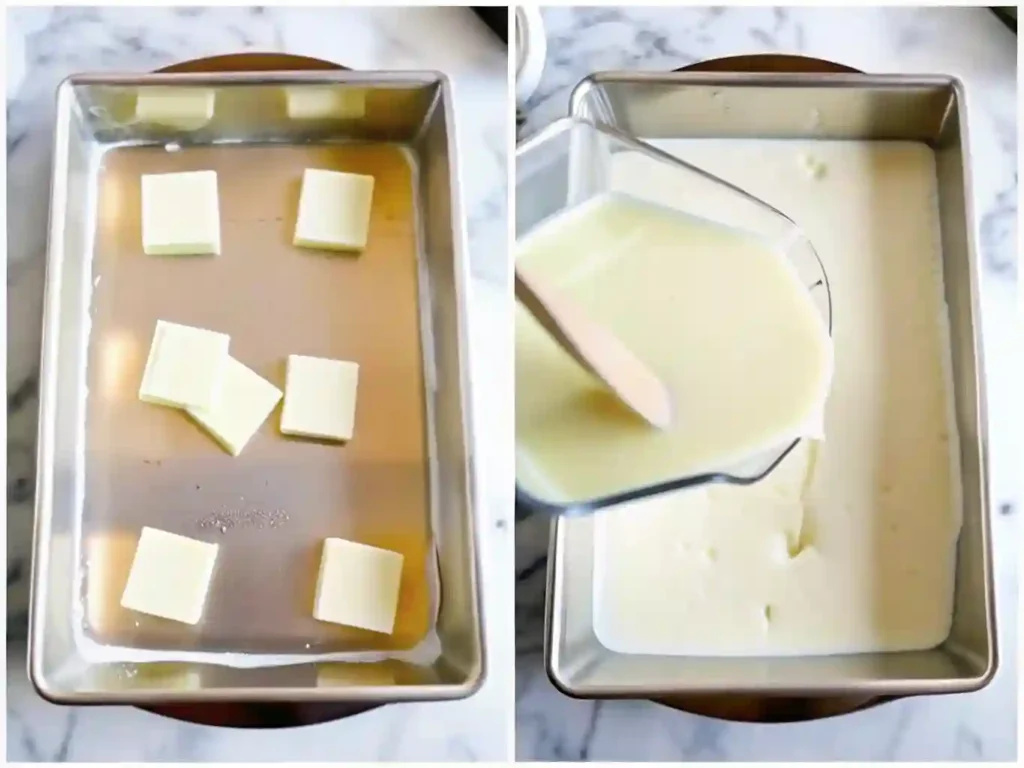
3. Pour the batter into the hot pan
Carefully remove the pan with melted butter from the oven. Immediately pour the batter over the hot butter. It may sizzle slightly at the edges, which is a good sign.
4. Bake until puffed and golden
Place the pan back into the oven. Bake for 22 to 27 minutes. The pancake should rise dramatically around the sides and turn golden brown. Do not open the oven during the first 20 minutes or you may lose the puff.
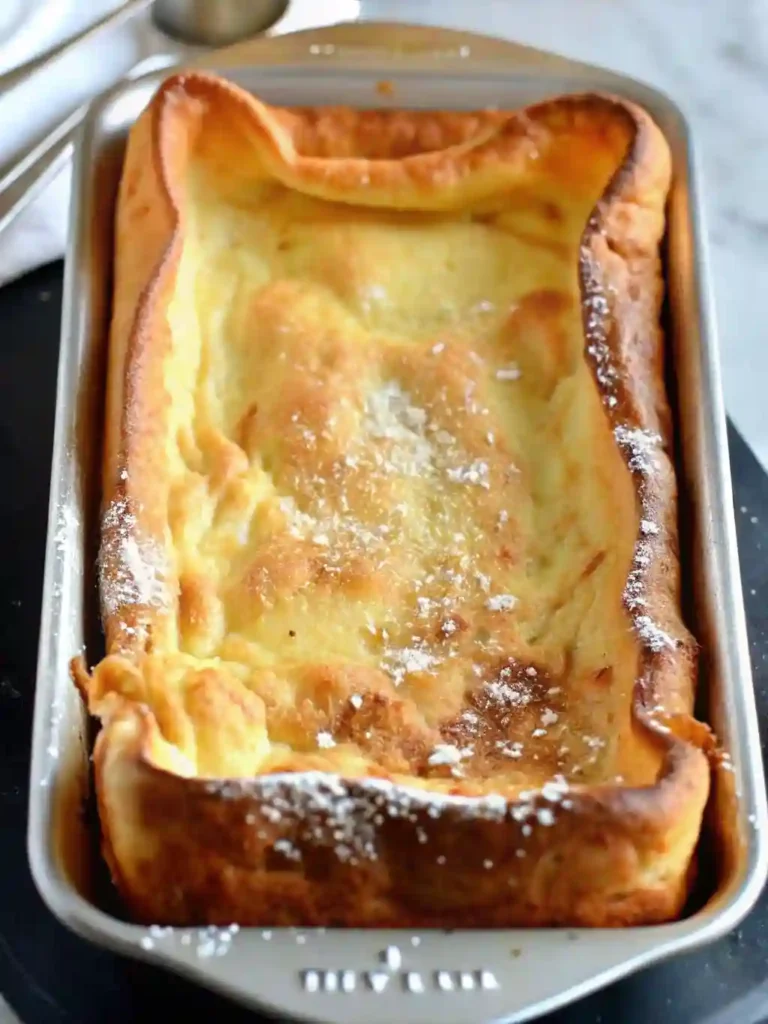
5. Serve immediately with your favorite toppings
Once the pancake is golden and puffed, remove it from the oven. Serve right away, as it will begin to deflate after a few minutes. Add powdered sugar, maple syrup, fresh berries, or whatever toppings suit your mood.
Frequently Asked Question
Why did my pancake not puff up?
There are a few common reasons. The oven might not have been hot enough. The batter could have been overmixed or under-mixed. Or you may have let the butter cool before adding the batter. Make sure everything is hot and freshly blended when you pour it into the pan.
Why Do German Pancakes Puff Up
The dramatic rise of a German pancake is what sets it apart from any standard flapjack. If you have ever wondered why this breakfast dish balloons in the oven before gently settling on your plate, here is what is really going on.
German pancakes rely heavily on steam. The batter has a high liquid content thanks to the eggs and milk. When that wet batter hits a hot pan and enters an already hot oven, steam forms rapidly and pushes the batter upward. That steam creates the puff, especially around the edges where the heat hits first.
Eggs also play a big role. They give the pancake structure. As the proteins in the eggs heat and set, they lock the air inside, allowing the pancake to hold its shape during the bake. Flour adds stability so the whole thing does not collapse right away.
The melted butter at the bottom of the pan helps with lift as well. It prevents sticking and also adds richness that contributes to the pancake’s golden brown edges and soft center.
What Happens After Baking
As the pancake cools, the steam escapes and the puff naturally falls. This is normal. The texture becomes soft and custard-like in the center, with lightly crisped edges that still hold shape.
Frequently Asked Question
Can I bake these at a lower temperature to avoid browning?
A lower temperature will reduce browning, but it will also reduce puff. For that signature rise, you need a hot oven. If browning is a concern, you can try placing the pan on a lower rack or loosely covering the pancake with foil for part of the bake.
Serving Ideas and Toppings
A freshly baked German pancake is a canvas for flavor. Once it leaves the oven, you have plenty of room to make it your own. Whether you lean sweet or savory, the topping possibilities are wide open.
Classic Sweet Combinations
- Powdered Sugar and Maple Syrup
This is the go-to pairing. A light dusting of sugar melts into the warm pancake while the syrup seeps into every bite. - Fresh Berries
Strawberries, blueberries, raspberries, or blackberries bring a burst of freshness. Toss them with a little sugar or lemon juice for extra shine. - Lemon and Butter
A drizzle of melted butter followed by a squeeze of fresh lemon juice creates a tangy-sweet contrast that brightens the dish.
Gourmet Twists
- Whipped Cream and Chocolate Shavings
Perfect for brunch or dessert. Add a touch of cinnamon or nutmeg for warmth. - Apple Slices and Cinnamon Sugar
Sauté sliced apples in a skillet with butter, cinnamon, and brown sugar until soft. Spoon them over the pancake for a cozy upgrade. - Nutella and Sliced Bananas
This combination turns your breakfast into a treat that feels indulgent without much effort.
Savory Variations
- Herbs and Cheese
Try topping with grated Gruyère or Parmesan and chopped chives. Add a soft-cooked egg for a protein boost. - Roasted Vegetables
Sautéed mushrooms, spinach, or onions can transform the pancake into a satisfying meal that works for lunch or dinner.
Frequently Asked Question
Can I serve German pancakes cold or at room temperature?
Yes, but they are best enjoyed warm. The texture and flavor are at their peak fresh from the oven. If you have leftovers, reheat them in the oven at a low temperature to revive the puff and crispness.
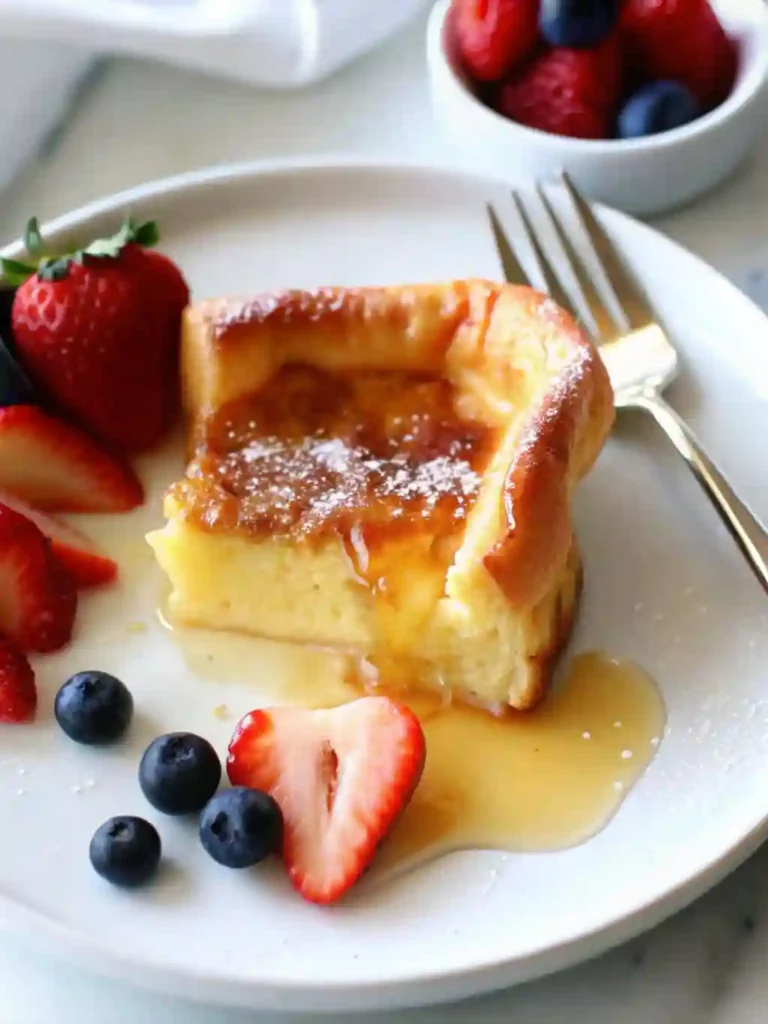
Tips for Perfect Puff Every Time
Getting that impressive rise from your German pancake is part technique and part timing. Here are the most effective ways to make sure your pancake lifts tall and golden with each bake.
Use a metal pan instead of glass
Metal heats up faster and holds consistent temperature. This helps create the steam burst needed for the pancake to rise. Glass pans can still work, but they tend to heat unevenly and may produce flatter results.
Preheat everything
Your oven should be fully preheated before you place anything inside. Let it reach a steady 425 degrees Fahrenheit. At the same time, melt your butter in the baking dish while the oven warms. Hot butter in a hot pan helps kickstart the puff as soon as the batter hits.
Blend the batter until smooth
A well-blended batter creates the right consistency for steam to form quickly. If your batter has lumps or is overmixed, the texture can suffer. Use a blender or whisk vigorously to remove any flour pockets.
Do not open the oven too soon
It is tempting to peek, but keep the door closed for the first 20 minutes. Interrupting the heat flow can cause your pancake to collapse early. Use the oven light if you need to check progress.
Bring ingredients to room temperature
Cold eggs or milk can slow the baking reaction and affect puff. Let your ingredients sit out for a few minutes before mixing to avoid this.
Frequently Asked Question
What if I do not have a blender? Can I still make the batter by hand?
Yes, you can use a large bowl and whisk the ingredients together. It will take more effort, but as long as the mixture is smooth and free of lumps, it will work just as well.
Substitutions and Variations
One of the best things about German pancakes is how adaptable they are. With a few tweaks, you can accommodate different diets or create new flavor profiles without sacrificing the puff or the pleasure.
Gluten-Free Option
Use a one-to-one gluten-free flour blend in place of regular all-purpose flour. Brands like King Arthur Measure for Measure and Cup4Cup work well. The texture may be slightly softer, but the rise remains strong.
Dairy-Free Option
Swap whole milk for unsweetened almond, oat, or soy milk. Use a plant-based butter alternative for the pan. Coconut milk can also be used for a richer texture and subtle sweetness.
Low-Sugar Variation
This recipe is naturally low in sugar, but if you want to cut down even further, skip the vanilla or use a sugar-free syrup. Top with fresh fruit for natural sweetness.
Add-In Ideas
- Cinnamon and nutmeg for a warm, spiced version
- Orange or lemon zest for a fresh citrus note
- Thin apple or pear slices baked directly into the batter
Savory Adaptations
If you prefer a non-sweet version, omit the vanilla and sugar. Add chopped herbs like thyme or chives to the batter. Once baked, top with grated cheese, sautéed vegetables, or a fried egg.
Frequently Asked Question
Can I make mini versions in a muffin tin?
Yes, pour the batter into a greased muffin tin, filling each cup about halfway. Bake at the same temperature but reduce the time to around 15 minutes. They will puff up individually and make great hand-held breakfasts.
Frequently Asked Questions (FAQ)
Can I prepare the batter the night before?
Yes, you can blend the batter ahead of time and store it in the refrigerator overnight. Be sure to stir it gently in the morning before pouring it into the hot pan. The pancake may puff slightly less than when using fresh batter, but it still turns out delicious.
What if I do not have a 9×13 inch metal pan?
You can use a similar-sized glass baking dish or a large cast iron skillet. Keep in mind that metal conducts heat more efficiently, which helps achieve a better rise. If using glass, expect a slightly softer edge and potentially less height.
How do I reheat leftovers?
Place slices of leftover pancake in a 300 degree Fahrenheit oven for about 8 to 10 minutes. This keeps the texture closer to the original. Avoid using the microwave if you want to retain crisp edges.
Can I freeze German pancakes?
Yes, let the pancake cool completely before wrapping it in foil or storing it in an airtight container. Freeze for up to two months. Reheat in the oven directly from frozen for best results.
Is this the same as a Dutch baby?
Yes, German pancakes and Dutch babies are two names for the same recipe. The term Dutch baby is more common in the United States, while German pancake references the dish’s European roots.
Nutrition Breakdown
German pancakes are simple and wholesome, built from familiar ingredients. While they feel indulgent, they can fit into a balanced breakfast with the right portion and toppings.
Per Serving (based on five servings):
- Calories: 300
- Total Fat: 18 grams
- Saturated Fat: 9 grams
- Cholesterol: 231 milligrams
- Sodium: 197 milligrams
- Carbohydrates: 21 grams
- Sugars: 2 grams
- Protein: 10 grams
- Fiber: Less than 1 gram
- Calcium: 92 milligrams
- Iron: 2.1 milligrams
- Vitamin A: 720 IU
- Potassium: 164 milligrams
Tips for Lightening It Up
- Use low-fat milk or a dairy-free alternative to reduce fat
- Swap half of the butter with a plant-based version
- Serve with fruit instead of syrup to cut added sugars
Frequently Asked Question
Is this recipe suitable for people with diabetes?
It can be adjusted to be more diabetic-friendly by reducing or eliminating syrup, using whole grain flour, and topping with fresh berries instead of sugary toppings. Always consult with a health provider or dietitian for individual guidance.
Conclusion
There is something deeply satisfying about a recipe that delivers both ease and elegance. German pancakes do exactly that. With just a few pantry staples and a single pan, you create a breakfast that feels like a treat without any fuss.
Whether you are making this for weekend brunch, a special family morning, or simply because you crave something cozy, this pancake offers more than taste. It brings a little lift to your day, both literally and figuratively.
Try it once and you may find yourself coming back to it again and again. Experiment with toppings, switch up the flavors, or share it with someone who has never seen a pancake puff like a balloon in the oven.
If you give this recipe a try, let us know how it turned out. Your version might just become someone else’s new favorite.
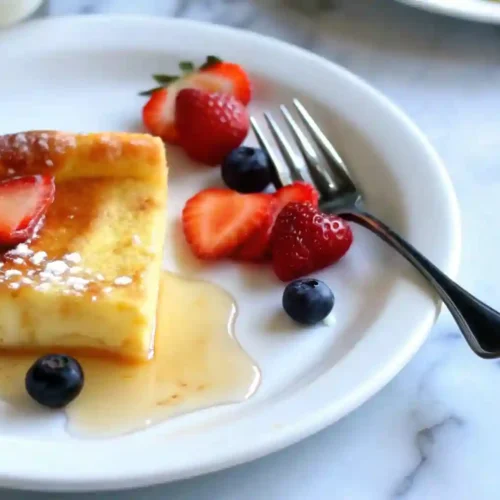
German Pancakes
Equipment
- Metal baking pan
- Blender
- Oven
Ingredients
Main Ingredients
- 6 large eggs
- 1 cup milk
- 1 cup all-purpose flour
- 1 teaspoon vanilla extract
- salt just a dash
- 5 tablespoons butter unsalted
Instructions
- Preheat the oven to 425°F. Place butter in an ungreased 9×13 inch metal baking dish and let it melt in the oven.
- While the butter melts, blend eggs, milk, flour, vanilla, and salt until smooth. Use a blender or whisk vigorously.
- Carefully remove the hot pan from the oven. Pour the batter over the melted butter immediately.
- Bake for 22 to 27 minutes or until puffed and golden around the edges.
- Serve warm with powdered sugar, syrup, or fresh fruit. Enjoy immediately.
Notes
- Calories: 300
- Total Fat: 18 grams
- Saturated Fat: 9 grams
- Cholesterol: 231 milligrams
- Sodium: 197 milligrams
- Carbohydrates: 21 grams
- Sugars: 2 grams
- Protein: 10 grams
- Fiber: Less than 1 gram
- Calcium: 92 milligrams
- Iron: 2.1 milligrams
- Vitamin A: 720 IU
- Potassium: 164 milligrams
Tips for Lightening It Up
- Use low-fat milk or a dairy-free alternative to reduce fat
- Swap half of the butter with a plant-based version
- Serve with fruit instead of syrup to cut added sugars
For more creative cooking & baking inspiration ideas, explore the Pinterest or connect with us on Facebook.


